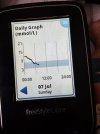Robin
Well-Known Member
- Relationship to Diabetes
- Type 1
- Pronouns
- She/Her
Just checked my original reader, and it’s the same as the Libre 2.Whats the formula ? Or is it something you can get from Libre reader. Mine is just Libre and not Libre 2. Still not latest tech
When you’ve swiped the sensor, and it’s displaying a reading, press the little button at the bottom right.Or if you’re not scanning, just press the button again when it displays the 'Check glucose' screen
Touch 'Review history' on the screen, it will display a list of options.
Touch the down arrow at the bottom of the screen to take you to the second page.
Touch 'Time in target'
It displays the time in range for 7 days, clicking the left hand arrow will give you 14 days, repeat for 30 days, and 90 days.

